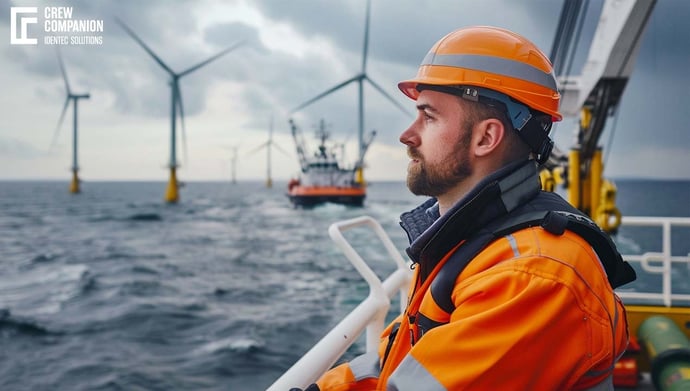EHS Audit on Offshore Installations: What to Look For
| Written by Michal Wozniakowski-Zehenter

No video selected
Select a video type in the sidebar.
Understanding an EHS Audit
So, what is an EHS audit, and why is it important? It is a systematic evaluation conducted to ensure that offshore installations comply with regulatory requirements and industry standards related to environmental protection, health, and safety. It assesses all parts of operations, from equipment maintenance and hazardous material handling to emergency response and environmental impact. The primary objectives of those audits are to identify noncompliance issues, evaluate the effectiveness of EHS programs, and recommend corrective actions to mitigate risks.
Key Aspects of an EHS Audit
The most significant chunk of it is adherence to regulations. Offshore installations need compliance with multiple local, national, and international laws. Such regulations are broad; they range from air and water quality to waste management and handling, occupational health, and safety and emergency preparedness. Noncompliance exposes one to enormous penalties, legal liability, and shutdown of operations. Understanding the regulatory framework under which such an environment operates is important. An EHS audit should also encompass risk management. Offshore facilities are exposed to almost every kind of risk, including high-pressure systems, flammable materials, and extremely uncertain weather conditions. Risk assessment procedures, safety management systems, and procedures for incident response (e.g. how to create a mustering report automatically) are all subject to audits in order to determine if the necessary identification, evaluation, and mitigation of everything threatening are performed in the most effective manner. Well-managed risks lead not only to safety but also to operational reliability.
Offshore installations have a high potential to pollute the environment. The EHS audit analyzes the environmental programs in place to mitigate these potential negative impacts, such as spillage, waste disposal, and emission reduction. Auditors also assess whether the programs are adequate to monitor the environment and meet the environmental legislation in place. Protection of the marine ecosystem and prevention of pollution are issues of paramount importance for ordering work according to regulations and gaining the public's confidence. The health and safety of personnel are very critical to any offshore installation. The EHS audit inspects the safety process, training schedules, and medical arrangements to safeguard people from occupational hazards. This would include assurance of personal protective equipment, emergency evacuation procedures, and occupational health monitoring (see our article about worker safety monitoring). Embedded safety culture is a very vital ingredient in accident prevention and the preservation of the workforce. Documenting and recording are very important in proving compliance and establishing correctness. An EHS audit reviews records such as safety inspection reports, incident records, and training and maintenance schedules. Proper documentation demonstrates compliance and marks the areas of improvement. It aids in ensuring transparency and accountability within the organization.
The EHS Audit Process
Preparation and planning are essential details of the audit process. The scope, objectives, and criteria of the audit are defined by the auditor and the auditee, management of the offshore installation. This would normally involve studying the previous audit reports, regulatory requirements, and company policies. Out of that, a detailed audit plan shall be drawn up, clearly indicating the audit schedule, the resources to be used, and the key areas for attention.
An opening meeting is conducted to explain audit team introductions, the objectives of the audit, and the process to be followed during the audit. It provides the stage for the audit and ensures that everybody is reading from the same script. OIM and other key personnel make known the expectations and clear any concerns or issues that may arise during the audit. Auditors inspect, interview, and make observations to gather evidence of compliance. This involves observing operational practices, inspecting equipment, and interviewing staff. The auditors' team examines safety practices, environmental controls, and emergency preparation. They also examine documentation and verification of records.
Data collected through an on-site assessment is analyzed for noncompliance issues, potential involved risks, and areas that necessitate improvement. This particular process of data analysis is arrived at through the measuring of evidence against requirements, standards, and best practices. The effectiveness of existing EHS programs and the implementation status of corrective measures of previous audits are also evaluated. A comprehensive report from these findings is created. The audit report outlines the scope of the audit, methodologies used, findings, and recommendations. These nonconformances are graded against their propensity to cause hazards and whether remedial measures should be taken. The report results are then discussed with the OIM and senior management in a closing meeting, and an action plan is done. For this, the audit team can make follow-up visits or status reports can be asked to see if the issues identified were corrected. Monitoring of performance and continual improvement is important in ensuring continued compliance and improved performance in EHS.
Critical Challenges in an EHS Audit
Of course, an EHS audit is no easy task, given the complex regulatory environment. The offshore installations have to meet the regulatory requirements of most jurisdictions, which might be quite uneasy. Adapting to changes and remaining compliant across all such boundaries is no mean feat; it calls for vigilance, complete understanding, and proactive management. An audit may prove to be disruptive to operations, especially if significant noncompliance issues are found. In dealing with all of these problems, temporary stoppages or changes in operations might result, leading to potential production losses. For an OIM, these problems are walking the tightrope that balances satisfying the requirements of the audit with maintaining operational continuity.
Resource limitations can result from insufficient personnel, time, and budget and hence can slow down the audit exercise. Most offshore installations operate with leanly manned setups. Hence, it becomes difficult for them to allocate resources to the preparation practices for audits and make time available for implementing corrective actions. Efficient management of resources and prioritization will be vital to surmount this constraint. Cultural barriers in the organization can severely affect the effectiveness of an EHS audit. This includes the absence of a safety culture, resistance to new ways, or ineffective channels of communication. Safeguards need to be ensured to strengthen the assurance and include open communication for the audit's success. Technological prohibitions include outdated equipment and insufficient monitoring systems. Advanced technologies for real-time monitoring and data analytics are becoming increasingly significant in the effectiveness of EHS management. Investment in modern technologies enhances the effectiveness of audits and operational efficiency.
Strategies for Better Preparation
An effective EHS management system is crucial for successful audits. As the system includes key components like risk assessment, safety measures, environmental monitoring, training, and incident reporting, it should be regularly reviewed to ensure its effectiveness and to stay updated with any regulatory changes. Therefore, internal audits are essential for identifying and addressing noncompliance issues before an external audit. These internal reviews allow for evaluating EHS performance, pinpointing gaps, and implementing corrective actions. They also help familiarize personnel with the audit process, enhancing their preparedness for external reviews.
Another recommendation is staying updated with regulatory changes for compliance. EHS managers' task is also to inform Offshore Installation Managers of any changes to regulations or industry standards. Indeed, proactively managing compliance helps avoid surprises during (external) audits.
Eventually, training and competency are essential for personnel to understand and follow EHS requirements fully, involving regular training programs on regulatory compliance, safety protocols, emergency preparedness, and environmental protection. Competency assessments show the workers' current level of experience and knowledge to perform their tasks effectively. If strong organizational safety and environmental culture exists, regulatory compliance is achieved, and the risk of incidents is reduced.
Modern technologies can easily open up EHS management and audit preparedness. Advanced systems for monitoring, data analytics, and digital documentation provide better accuracy and improved efficiency. Real-time monitoring gives relevant insight into operational performance and the opportunity to identify problems before they actually materialize. An embracing of technology improves audit effectiveness and enhances operational resilience. External consultants can offer expert consultancy services and insight. This is also the area where consultants can offer services to address such needs: pre-audit assessments, training, and recommendations for improvement. Their independent experience, yet knowledge of industry players, affords a pair of fresh eyes toward blind spots and improves audit readiness.
Any noncompliance found during audits should have a very robust corrective action plan. It needs to specify what is going to be done, who will implement the action, how long it will take to complete it, and what means will be used to monitor its completion. Follow-up on a regular basis provides room for proper implementation of correct actions and sustenance of improvement. Proper documentation also serves to show proof of compliance and performance tracking. Ensure that OIMs maintain meticulous records for everything: safety inspections, incident reports, training records, maintenance logs, etc. Proper documentation gives proof of compliance and feels through audit processes. Conducting mock audits is one of the effective ways to prepare an external audit. A mock audit simulates the audit process so that organizations recognize potential issues and resolve them before actual auditing. They also familiarize personnel with the audit process and reduce apprehension (see also: electronic T-card systems).
FAQ
What is EHS audit?
An EHS (Environmental, Health, and Safety) audit is a comprehensive review and evaluation of an organization's adherence to regulatory standards, internal policies, and best practices related to environmental protection, occupational health, and workplace safety. The primary goal of an EHS audit is to ensure compliance with relevant laws and regulations, identify potential risks, and implement measures to mitigate those risks. Auditors assess various aspects of an organization's operations during an audit, including waste management, air and water quality, hazardous materials handling, emergency preparedness, employee health and safety protocols, and overall environmental impact. Audit typically involves reviewing documentation, inspecting facilities, interviewing employees, and observing work practices. The findings help organizations identify areas of noncompliance, understand the root causes of any issues, and develop corrective action plans to address these shortcomings. Regular EHS audits are crucial for maintaining regulatory compliance, preventing accidents and environmental incidents, and fostering a culture of continuous improvement in health and safety practices.
TAKEAWAY
An EHS audit is important for the safety, health, and environmental sustainability of offshore installations. For OIMs, understanding the critical aspects of those audits, their processes, and the challenges involved is crucial for maintaining operational continuity and regulatory compliance. By developing a comprehensive EHS management system, conducting regular internal audits, staying informed about regulatory changes, enhancing training and competency, fostering a positive safety culture, investing in technology, engaging with external consultants, developing a robust corrective action plan, maintaining accurate documentation, and conducting mock audits, OIMs can better prepare for an EHS audit and ensure the continuous, safe operation of their installations. The proactive approach to EHS management enhances compliance and improves overall operational efficiency and resilience, contributing to offshore installations' long-term success and sustainability.
Delve deeper into one of our core topics: Personnel on Board
Sources:
(1) https://www.worldoil.com/magazine/2011/december-2011/special-focus/auditing-offshore-facilities-for-safety-and-environmental-management-systems/
(2) https://www.centerforoffshoresafety.org/Guidelines-and-Reports/SEMS%20Auditing

Author
Michal Wozniakowski-Zehenter, Marketing Manager
Michal Wozniakowski-Zehenter is an experienced marketing and project management professional. He spent most of his career on projects with a strong focus on digital marketing and event management. He is a very active voice representing offshore and mining industries through social media channels. Michal writes mainly about offshore oil and gas, renewable energy, mining and tunnelling. Compiling and sharing the knowledge within industries is one of his goals.




